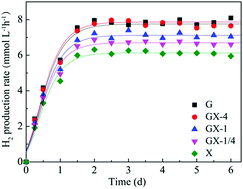Continuous hydrogen production from glucose/xylose by an anaerobic sequential batch reactor to maximize the energy recovery efficiency
Abstract
Fermentation of both glucose and xylose is essential to realize efficient bioconversion of renewable and abundant lignocellulosic biomass to hydrogen. In this study, a mixture of glucose and xylose at different ratios was used as a substrate for biological hydrogen production by an anaerobic sequential batch reactor (ASBR). An average glucose and xylose consumption of 80% and 50% with a high hydrogen production rate of 7.1 ± 0.9 mmol L−1 h−1 was obtained, respectively. Hydraulic retention time (HRT) played a critical role in hydrogen production at high glucose to xylose ratios. A maximum hydrogen production rate of 8.9 mmol L−1 h−1 was achieved at an optimized HRT of 12 h with a high glucose and xylose consumption of 92.2% and 82.2%, respectively. Upon further energy conversion analysis, continuous hydrogen production by ASBR provided the maximum energy conversion efficiency of 21.5%. These results indicate that ASBR can effectively accelerate the hydrogen production rate, improve substrate consumption regardless of the glucose to xylose ratio, and thus provides a new direction for efficient hydrogen production from lignocellulosic feedstock.



 Please wait while we load your content...
Please wait while we load your content...